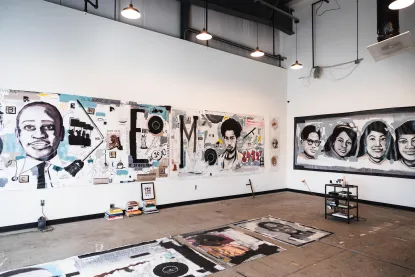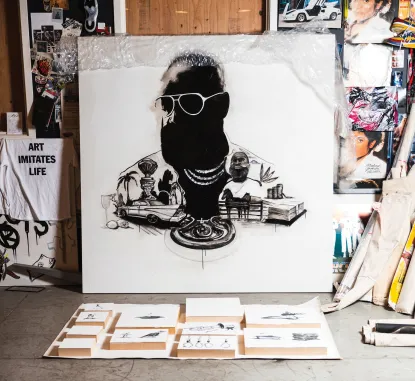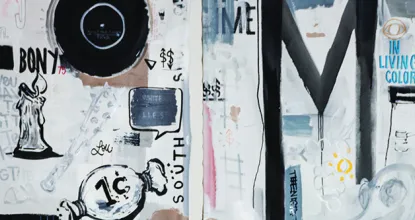
"You can’t help it. An artist’s duty, as far as I’m concerned, is to reflect the times.” — Nina Simone
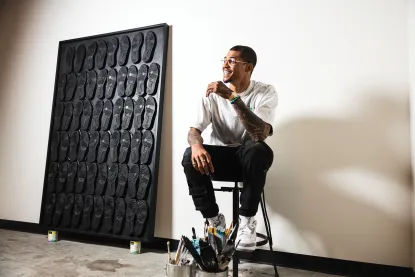
With a quote
is how Julian Gaines often introduces his artwork on Instagram @juworkingonprojects. This one accompanied an oil-on-wood-panel drawing of the left foot of Ahmaud Arbery wearing a Nike shoe, with a wing extending from his ankle. It is titled “Just Joggin.”
This is the kind of head-on art that has landed the former Wildcat football player gigs as freelance creative director for Nike and painter for the hip hop label Jet Life Recordings. As a fulltime professional artist, in the past year alone, he has been featured on two covers of The New Yorker, had a solo show at the Steven Harvey Fine Arts Project in New York City, a painting of James Baldwin displayed at a Paris gallery, and designed a campaign for Maker’s Mark and a project for California’s groundbreaking ComplexCon festival. Gaines’ black and white painting of Ben Wilson, a rising star high school basketball player who was shot and killed in 1984, just sold at Philips New York Auction for more than $20,000.
To top it all off, LeBron James was recently spotted courtside at a Laker’s game wearing the Gaines-designed, avocado-colored swoosh, Sky Force Nikes.
“My goal is to be an Old Master,” Julian said. “And to be the greatest artist of this generation. That’s what I’ve set out to do in whatever capacity that is, because I think about the Black boys and girls, and especially the Black boys where I’m from in Chicago, where they really have to make a decision to either rap or play ball. Not many people get to paint their way out of situations. I’m trying to use myself as a vessel to tastefully tell the stories that need to be told. We need to know them.”
He explained that he doesn’t paint for himself or take commissions. “I paint what I want to paint, but it’s not solely for my benefit. I paint thinking that someone’s watching me. By doing what I’m doing, moving how I move, I will be able to help them. They may not have to do ’this,’ whatever this is, but just be able to do what they really want to do.
“In the same way the Jordan brand shoe makes people feel like they can dunk the basketball, I want my shoe or my projects to make people feel that inspired. If Julian can do this, why can’t I do that?”
When Northern Magazine visited his studio outside of Portland, Oregon, in May, he explained his process as the team looked at a series of gigantic paintings on unstretched canvases – his medium of choice. “I engulf myself in content about whatever the subject is. For instance, I did a painting for [NBA player] D’Angelo Russell of Ali, he’s a huge Ali fan, and I listened to Sam Cook the entire time, because I found out they were friends. The way I paint is not so much about the subject, but the year. I watch a slew of documentaries to learn and get my content.”
One canvas featured Emmett Till, with artifacts, images and quotes from 1955, the year that the 14-year old was lynched, mutilated and shot to death. Next to that was one of Michael Stewart, who was arrested for graffiti on September 15, 1983 and died from police brutality. And then adjacent, portraits of the four girls who died on that same day in 1963 in a Birmingham, Alabama, church when it was dynamited by the Ku Klux Klan.
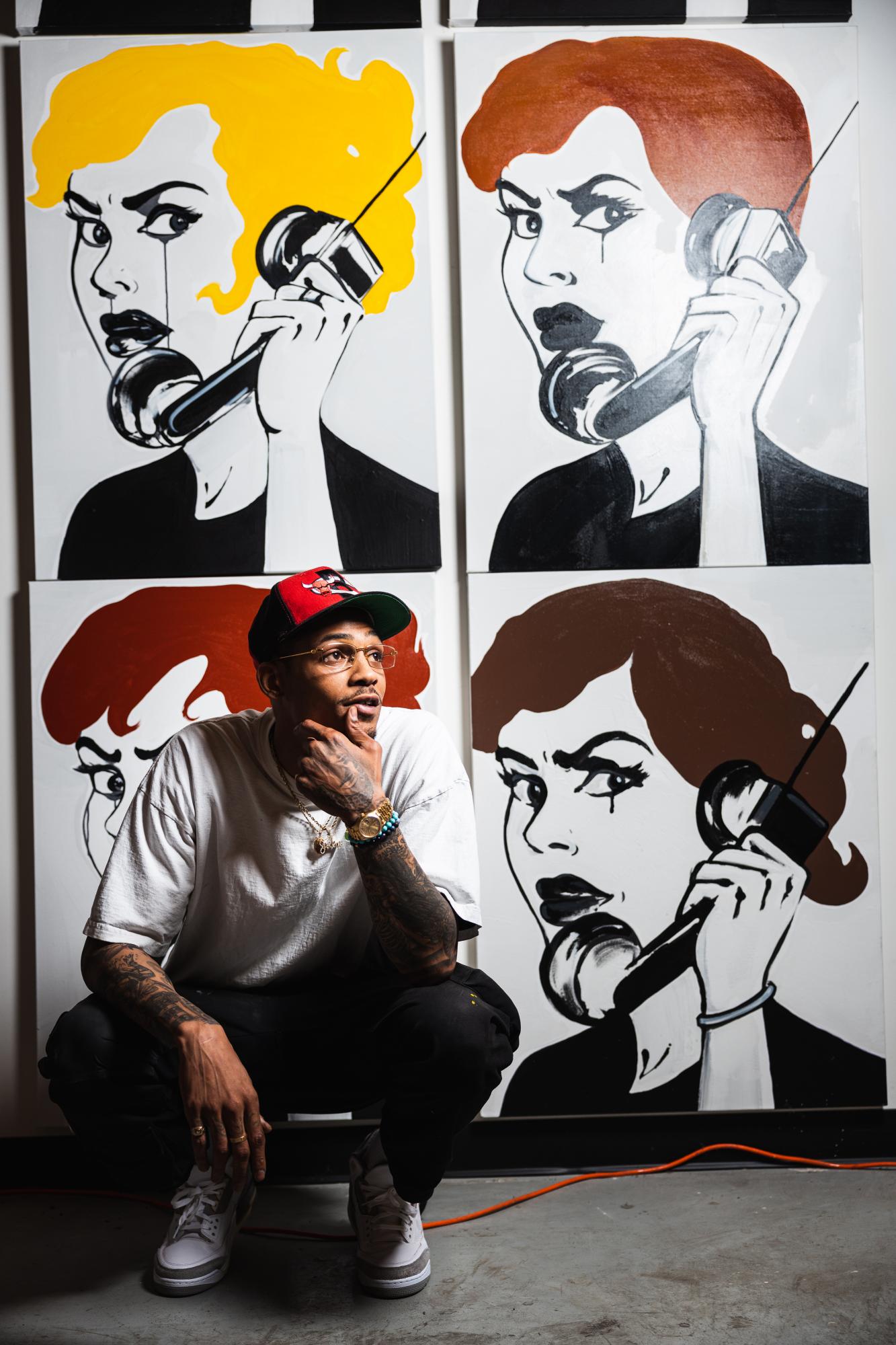
At NMU, Gaines—who has an associate degree in graphic design (’13), a BFA in painting (’15) and a BS in physical education training and coaching (’15)—learned a lot about himself, his athletic goals and personal goals. “When I tore my labrum for the first time as a senior, it allowed me to see a different side of being an college athlete and a college student. I had been getting up at 4 in the morning, going to practice and meetings for the majority of the day. When I couldn’t do those things, I was allowed to see daylight, and see what kids were doing outside of being an athlete. The most rewarding thing in the midst of this adversity was that I spent more time in the studio and my art started to get better. At the same time I started realizing that I may not be able to go to the NFL. My prayer was exactly this: If I can’t be a professional athlete, Lord help me be a professional artist. At that point I thought if I could transfer the same grind, the same intention, the same work ethic into art and creativity and consultancy then I should be just fine.”
He credits his art and design professor John Hubbard for getting him to that point. “He really helped change my life as an artist. It wasn’t so much what he did, but what he said, and he was a man of few words. The one assignment that really lit a fire for me was when he gave me a C. I was so offended. He told me, ’I know you can do so much better.’ Then my competitive athletic mindset was to show him that I can do better. I thank him for that and think about that time often. I collect art as well, and one of my most valued pieces is one that he drew of me in class. I cherish that piece. Even my studio is inspired by his classroom. He really left a mark on me.”
Gaines firmly believes that every person should go to college. “It’s not about your grade point average or how well you did in school. No one ever asks what your grades were, they just want to know what your major was and did you graduate. Going to college is a test to see if you can deal with the real world. Are you dependable? Can you be on time?” He also emphatically believes that children should be in organized sports because it develops a strong work ethic and accountability. He pointed out that former athletes often successfully transfer that work ethic into their new profession. Just as he has.
In hindsight, he said, “I find it almost eerily identical that being an artist is very much like being a wide receiver— as we are on our own island trying to figure out the next play and create an openness so that we can score.”
Juxtaposing art and athletics comes relatively easy for Gaines. “Without aesthetics, athletics doesn’t propel,” he says. One of the projects he is most proud of is his Nike Game Worn Collection collaboration, based on two 1980s sneaker silhouettes. His shoe designs include his signature spray-painted outsole, his art on the insoles and custom hangtags. With the money generated by the shoe’s sales, he was able to provide more than 500 scholarships to youth in Chicago and hold a weeklong creative workshop bootcamp for them.
As I got older, I realized that success is a great credit score. To be able to do whatever you want to do, when you want to do it, is the real wealth. I’ve been able to keep my overhead low, sacrifice frivolous activities, even if they seemed enticing, to get to my goal.
“I understand what I want my work to do. I don’t paint for home; I paint for museums, whether they make it in museums or not. That’s the level that I aspire to be at. I’ve never dreamt small. I’ve had dreams not come true, but I still get something out of it because I dreamt so high.
“For me to be painting in the Palm Tribeca in New York, that’s not about a grandiose thing to make me feel good. It’s for a kid who’s going to say, ’Who’s Julian Gaines?’ He’s a painter, from Northern Michigan University.
“Dog, are you telling me that anything is not possible? I’m just a living example of that. My collectors, my friends, my family, my university (hey, I’ve got a Wildcat tattoo on my arm of me catching a touchdown)… it does all of them a disservice if I don’t feel like I could be as big as Damien Hirst, as great as David Hammons. Sit at the table with George Condo and eat with Kerry James Marshall. Or, hey, look at Steve Mariucci—he makes the university look good! Wildcat alumni are the most known unknowns.”
Interview by Mike Forester ’09 BFA
Edited by Rebecca Tavernini ’11 MA
Photos by Ryan Stephens ’15 BS

